|
Doctor Piot and the Hideo Noguchi Africa Prize (No.23)
12th of July 2013
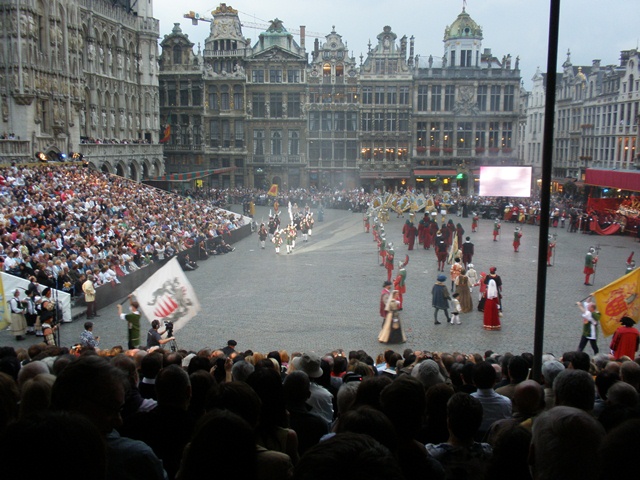 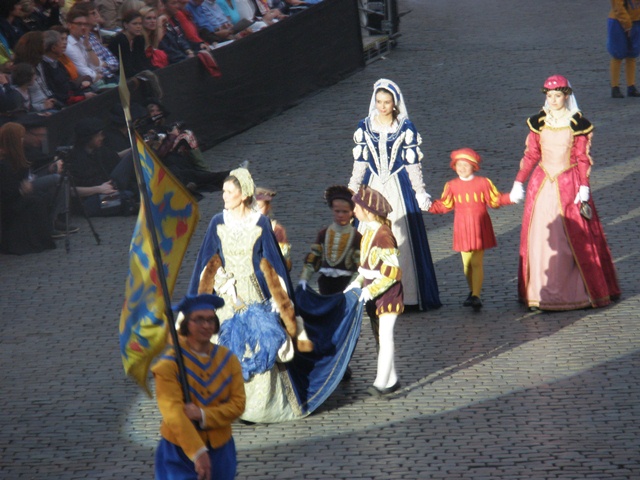 At the beginning of last week, the “Ommegang” which is said to be the biggest yearly cultural event in Belgium was held at the central square called Grand Place. In spite of the sporadic rain, there was a big crowd. At this “historical pageant” the welcoming parade for Charlemagne of the Holy Roman Empire when he visited Brussels at the beginning of the 16th century is re-enacted. The parade is led by the flag of Brussels and followed by bands and more than 1400 people dressed up as nobility, lords, knights and guild craftsmen. It feels as if the gorgeous Middle Ages are revived in front of you, which makes this parade also popular among tourists. Because the Ommegang is often shown on travel TV programs in Japan, many Japanese might know this event, if they have not already actually seen it. It is said that the “Ommegang” in its current form began in the middle of the 16th century, but its origin can be traced back to a pilgrimage that started mid-14th century in the Notre-Dame-du-Sablon Church. It is indeed a surprisingly old event. The name “Ommegang” is a combination of the old Flemish words “Omme (round)” and “Gang (walk)” and it means “go around”. The “Ommegang” in the 21st century has become a major tourist event with the battle of the stilt walkers and the parade of the giants carried out by youth organizations, even the famous “Gilles” of Binche make their appearance and at the end fireworks are set off in grand style. At the beginning of last week, the “Ommegang” which is said to be the biggest yearly cultural event in Belgium was held at the central square called Grand Place. In spite of the sporadic rain, there was a big crowd. At this “historical pageant” the welcoming parade for Charlemagne of the Holy Roman Empire when he visited Brussels at the beginning of the 16th century is re-enacted. The parade is led by the flag of Brussels and followed by bands and more than 1400 people dressed up as nobility, lords, knights and guild craftsmen. It feels as if the gorgeous Middle Ages are revived in front of you, which makes this parade also popular among tourists. Because the Ommegang is often shown on travel TV programs in Japan, many Japanese might know this event, if they have not already actually seen it. It is said that the “Ommegang” in its current form began in the middle of the 16th century, but its origin can be traced back to a pilgrimage that started mid-14th century in the Notre-Dame-du-Sablon Church. It is indeed a surprisingly old event. The name “Ommegang” is a combination of the old Flemish words “Omme (round)” and “Gang (walk)” and it means “go around”. The “Ommegang” in the 21st century has become a major tourist event with the battle of the stilt walkers and the parade of the giants carried out by youth organizations, even the famous “Gilles” of Binche make their appearance and at the end fireworks are set off in grand style.
< Dinner for Dr. Piot, Winner of the Hideyo Noguchi Africa Prize >
Beginning of this week, I held a dinner at the Ambassador’s Residence in honour of Dr. Peter Piot, Director of the London Institute of Hygiene and Tropical Medicine, to which I invited Belgian people from all walks that had some connection with Dr. Piot. Like me, Dr. Piot is born in 1949 and after getting his doctoral degree at the University of Antwerp, he went to Africa where he discovered the Ebola virus, the cause of haemorrhagic fever. He addressed the AIDS problem as well and for many years he did research and field work. After that, he occupied an important position at the United Nations dealing with infectious diseases and about 3 years ago Dr. Piot became Director of the London Institute of Hygiene and Tropical Medicine. The relationship with Japan is also deep and he has visited Japan about 30 times. He seems to enjoy a drink at the stalls under the Shinbashi railway in Tokyo. Dr. Piot told me about the award ceremony that was held in Yokohama on June 1st in the presence of their Majesties the Emperor and Empress of Japan and where he received the prize from the hands of Prime Minister Abe. He told me that the emotion he felt at that moment will be a lifetime memory. The Hideyo Noguchi Africa Prize was established by the Japanese government 5 years ago. Every 5 years, two people (one African, one non-African) who have made outstanding achievements in the field of tropical medicine and infectious diseases are honoured and each one is awarded ¥100 millions (about 770.000 euro). Everyone knows Dr. Noguchi in Japan and he is such a great man that his portrait is even printed on the thousand-yen bill. However, except for specialists of infectious diseases, he is not well known abroad. At the dinner that day, I praised the achievements of Dr. Piot and at the same time I introduced Dr. Hideyo Noguchi, a great man of modern Japan, to my guests. It makes me very happy as ambassador that Belgium and Japan are connected in this way.
< Meeting with Two Politicians in Leuven >
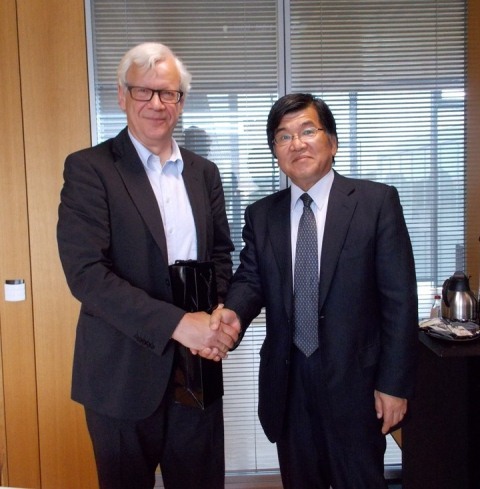 Last month, I visited Leuven, located 30 km east of Brussels, where I paid a courtesy call to Mr. Lodewijk DE WITTE, Governor of Flemish Brabant. The governor has been in his current post for the long time of 18 years and a half, ever since the province of Flemish Brabant was formed by the separation of the province of Brabant in 1995. He is on the way of having the longest term in office for a governor. Flemish Brabant is geographically surrounding Brussels Capital Region. In other words, Brussels is like an isolated island in Flemish Brabant and is becoming more and more a commuter town for the people that work in the capital. As a result, the main roads to Brussels are extremely congested in the morning and evening and the number of foreign residents continues to increase. Mr. De Witte told me that a solution for the traffic problem is an urgent matter. Last month, I visited Leuven, located 30 km east of Brussels, where I paid a courtesy call to Mr. Lodewijk DE WITTE, Governor of Flemish Brabant. The governor has been in his current post for the long time of 18 years and a half, ever since the province of Flemish Brabant was formed by the separation of the province of Brabant in 1995. He is on the way of having the longest term in office for a governor. Flemish Brabant is geographically surrounding Brussels Capital Region. In other words, Brussels is like an isolated island in Flemish Brabant and is becoming more and more a commuter town for the people that work in the capital. As a result, the main roads to Brussels are extremely congested in the morning and evening and the number of foreign residents continues to increase. Mr. De Witte told me that a solution for the traffic problem is an urgent matter.
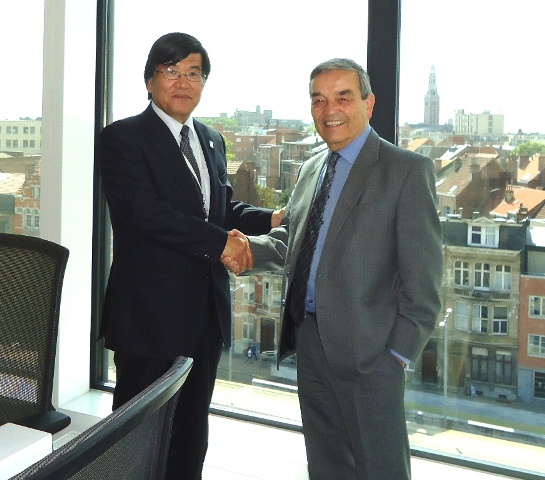 One week later, I met with Mr. Louis TOBBACK, Mayor of Leuven. Just like Governor De Witte, Mr. Tobback has been in his current post as mayor since 1995 and he played an important role in modernizing the historical city of Leuven. Apart from completely renovating the central station into an ultra-modern station building, he moved 5 years ago from the old town hall that was built mid-15th century to a new 7-story building with glass fittings. Although there are 94.300 inhabitants in Leuven, it is also a university city, home to the Katholieke Universiteit Leuven (KUL), which means that during the daytime on weekdays tens of thousands of students are added to the population. In addition to the international research institute IMEC (see Ambassador’s Chat No.20), there is a large industrial park on the outskirts where Japanese companies such as Terumo and GC Europe are operating. Leuven is full of eternal charm, evoking a mysterious atmosphere in which a medieval town and futuristic architecture coexist. One week later, I met with Mr. Louis TOBBACK, Mayor of Leuven. Just like Governor De Witte, Mr. Tobback has been in his current post as mayor since 1995 and he played an important role in modernizing the historical city of Leuven. Apart from completely renovating the central station into an ultra-modern station building, he moved 5 years ago from the old town hall that was built mid-15th century to a new 7-story building with glass fittings. Although there are 94.300 inhabitants in Leuven, it is also a university city, home to the Katholieke Universiteit Leuven (KUL), which means that during the daytime on weekdays tens of thousands of students are added to the population. In addition to the international research institute IMEC (see Ambassador’s Chat No.20), there is a large industrial park on the outskirts where Japanese companies such as Terumo and GC Europe are operating. Leuven is full of eternal charm, evoking a mysterious atmosphere in which a medieval town and futuristic architecture coexist.
< Two Ports Supporting the Belgian Economy >
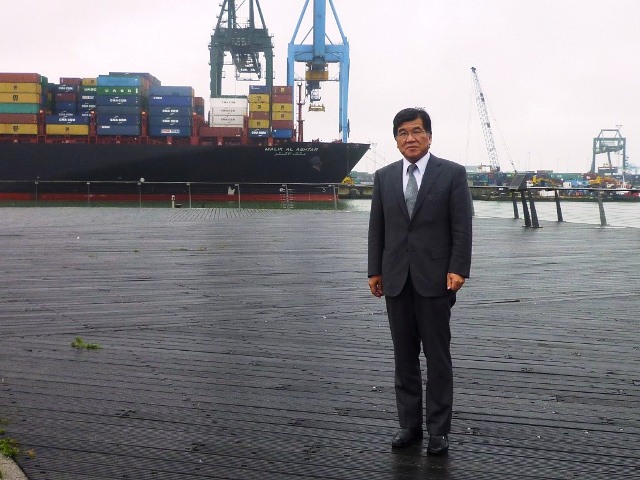 Last week, I visited the Port of Zeebruges, located on the northwest edge of Belgium. According to Mr. Joachim Coens, Director-General of the Port Authority, this deep-water port with a depth of 17-18m is suitable for container cargo transport by large ships and, being a European hub, there is a great demand for import and export of automobiles (1.7 million cars annually). In fact, Japanese car manufacturers such as Toyota and Mitsubishi make more and more use of the port and 35% of car-related transport is taken up by Japanese cars. Furthermore, Japanese companies are important customers for the Port Authority because of the tire storage facility of Bridgestone and the factory of AGC Glass Europe (affiliated with Asahi Glass Co. Ltd.) on the port site and the Daikin factory in the neighbourhood. Although the Port of Zeebruges is a relatively new port, opened in 1905, it has for many years a sister port relationship with the Port of Hakata in Japan and another sister port relationship with the Port of Nagoya will be established as well this month. The relationship with Japan will get stronger and stronger in the future. Last week, I visited the Port of Zeebruges, located on the northwest edge of Belgium. According to Mr. Joachim Coens, Director-General of the Port Authority, this deep-water port with a depth of 17-18m is suitable for container cargo transport by large ships and, being a European hub, there is a great demand for import and export of automobiles (1.7 million cars annually). In fact, Japanese car manufacturers such as Toyota and Mitsubishi make more and more use of the port and 35% of car-related transport is taken up by Japanese cars. Furthermore, Japanese companies are important customers for the Port Authority because of the tire storage facility of Bridgestone and the factory of AGC Glass Europe (affiliated with Asahi Glass Co. Ltd.) on the port site and the Daikin factory in the neighbourhood. Although the Port of Zeebruges is a relatively new port, opened in 1905, it has for many years a sister port relationship with the Port of Hakata in Japan and another sister port relationship with the Port of Nagoya will be established as well this month. The relationship with Japan will get stronger and stronger in the future.
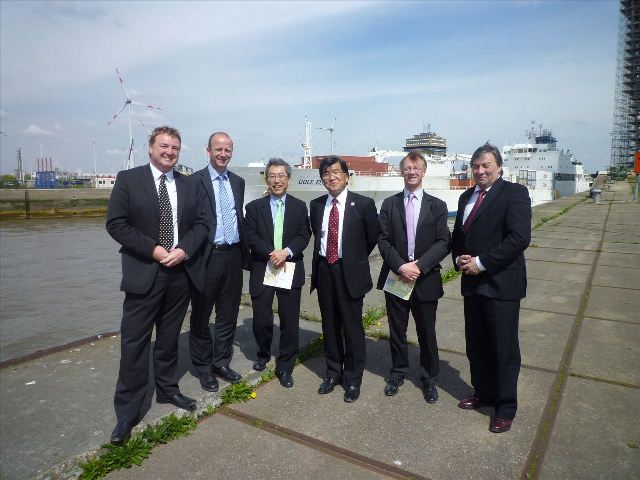 End of last April, I visited the Port of Antwerp which is the largest port in Belgium. According to the Port Authority, the harbour covers an area of more than 13000 ha, which is really vast, so I was surprised to hear that there is still more than 1000 ha left to expand. Overlooking the harbour, I was overwhelmed by the forest of factories of the world’s largest chemical companies and by the endless warehouses. The container handling capacity is 15 million TEU per year and the total amount of cargo handled last year was 184 million tons. It is the second largest port in Europe after Rotterdam. Characteristic of the Port of Antwerp is its geographic location in a huge bay entering considerably inland, which makes the main cities in France, Germany and the Netherlands easily accessible. In relation with Japan, all major shipping companies use this port and many companies have factories and warehouses on the port site. The Port of Antwerp has already a sister port relationship with the Port of Nagoya and a ceremony to celebrate the 25th anniversary is planned for the end of August this year. I was a little surprised to hear that the economic activities related to the Port of Antwerp generate 5% of the Belgian GDP. End of last April, I visited the Port of Antwerp which is the largest port in Belgium. According to the Port Authority, the harbour covers an area of more than 13000 ha, which is really vast, so I was surprised to hear that there is still more than 1000 ha left to expand. Overlooking the harbour, I was overwhelmed by the forest of factories of the world’s largest chemical companies and by the endless warehouses. The container handling capacity is 15 million TEU per year and the total amount of cargo handled last year was 184 million tons. It is the second largest port in Europe after Rotterdam. Characteristic of the Port of Antwerp is its geographic location in a huge bay entering considerably inland, which makes the main cities in France, Germany and the Netherlands easily accessible. In relation with Japan, all major shipping companies use this port and many companies have factories and warehouses on the port site. The Port of Antwerp has already a sister port relationship with the Port of Nagoya and a ceremony to celebrate the 25th anniversary is planned for the end of August this year. I was a little surprised to hear that the economic activities related to the Port of Antwerp generate 5% of the Belgian GDP.
< The Largest Beer Company in the World >
As mentioned before, I was in Leuven last week and I also paid a visit to the world’s largest beer maker, AB InBev, headquartered in the city. The company’s global market share is said to be more than 25% now. Considering that beer is being produced anywhere in the world right now, the height of this share is phenomenal. However, it is surprising that not many Belgians know this fact. The reason why it is not well known is that, making an analogy with the world of sports, an unknown player suddenly became the world champion, which is what happened in the past quarter-century. The beginning was the merger in 1987 between the brewer of the beer “Stella Artois” and Piedboeuf, brewer of the beer “Jupiler”, which led to the establishment of the new company Interbrew. In 2004 Interbrew merged with the Brazilian AmBev to form InBev. Moreover, in 2008 and 2013 InBev acquired a huge American and Mexican beer company and in no time it grew into a giant company with total assets up to 112.4 billion dollars and 120.000 employees. It is said that the first Belgian brewery Artois started its business mid-14th century, but who would have imagined that through the course of 650 years this small company was to become the world’s biggest brewer…
< The Japanese Garden in Hasselt >
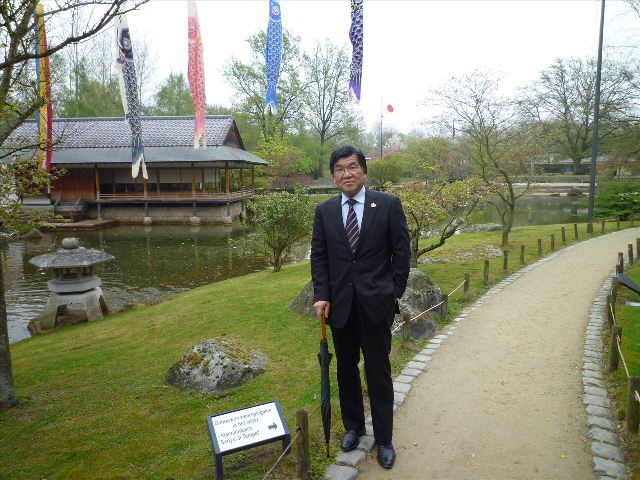 There is one prominent Japanese Garden in Belgium, even across Europe, located in Hasselt, capital city of the province of Limburg (see Ambassador’s Chat No. 16). When you get out of the car at the entrance of the forest on the outskirts of the city and pass through the vermillion torii, a garden measuring 25.000m² spreads out in front of you. Carps swim around in a pond and waterfalls, a log bridge, a bower, a tea house and cherry blossoms are all present. This garden that makes you feel as if you were in Japan was completed in 1992 through technical cooperation with the city of Itami in Japan and celebrated last year its 20th anniversary. Hasselt and Itami became sister cities in 1985 and for the 5th anniversary of the sister city partnership Hasselt donated a Carillon tower (Flemish bells) to the square in front of the JR Itami Station. In return, the city of Itami landscaped a Japanese garden. Hasselt organizes every year various cultural events in this garden and it is also a place of recreation and relaxation for the citizens. Three years ago a 160-page book on this Japanese garden was completed and because of the many photos in it, it is used a lot as an affordable introduction to the city sights. I visited the garden end of last April and even though the cherry blossoms were past their prime, the late-blooming cherry blossoms were a beautiful sight. That a sister city partnership can come this far is magnificent… There is one prominent Japanese Garden in Belgium, even across Europe, located in Hasselt, capital city of the province of Limburg (see Ambassador’s Chat No. 16). When you get out of the car at the entrance of the forest on the outskirts of the city and pass through the vermillion torii, a garden measuring 25.000m² spreads out in front of you. Carps swim around in a pond and waterfalls, a log bridge, a bower, a tea house and cherry blossoms are all present. This garden that makes you feel as if you were in Japan was completed in 1992 through technical cooperation with the city of Itami in Japan and celebrated last year its 20th anniversary. Hasselt and Itami became sister cities in 1985 and for the 5th anniversary of the sister city partnership Hasselt donated a Carillon tower (Flemish bells) to the square in front of the JR Itami Station. In return, the city of Itami landscaped a Japanese garden. Hasselt organizes every year various cultural events in this garden and it is also a place of recreation and relaxation for the citizens. Three years ago a 160-page book on this Japanese garden was completed and because of the many photos in it, it is used a lot as an affordable introduction to the city sights. I visited the garden end of last April and even though the cherry blossoms were past their prime, the late-blooming cherry blossoms were a beautiful sight. That a sister city partnership can come this far is magnificent…
|

